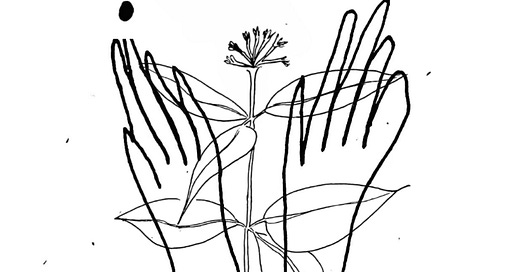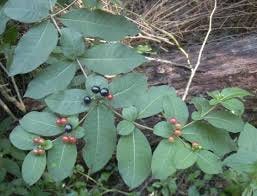ALSO KNOWN AS: Rauvolfia serpentina, chandrika, Indian snakeroot, sarpagandha, devil pepper, shégēn mù, yìndù shémù, pagal-ki-dawaa
How to know
three to five leaves circle the stem
trumpet shaped flowers
pink sepals
those petals fall to reveal orbs of glowing black berries
almond leaves
roots like snakes
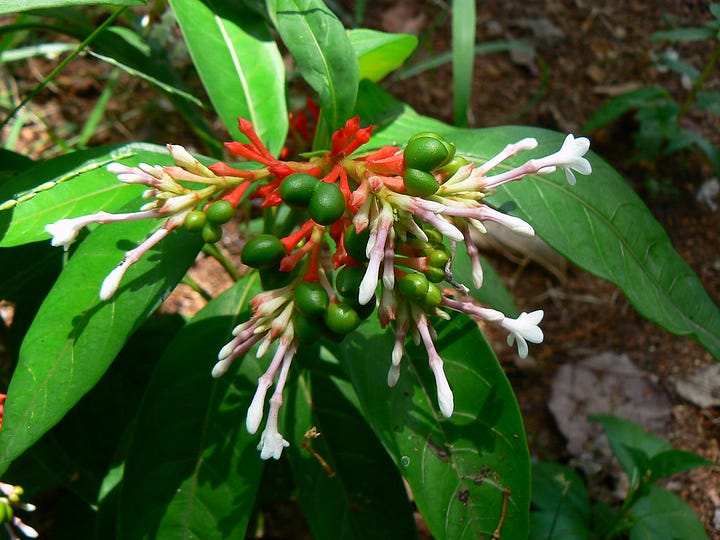
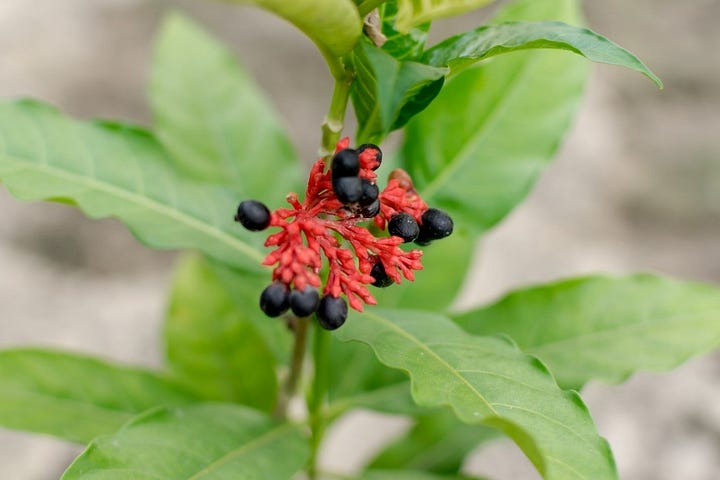
We are a young and foolish species in many ways. But the only way we got this far was through observation and listening. Plants developed and adapted millennia before we even had feet, but many animals had also adapted far before we did. Some of them adapted so that their bodies fit flowers, so that their digestive systems could break down and distribute botanical chemicals and seeds that rejuvenated the earth. People learned what plants to eat through watching animals, as Robin Wall Kimmerer reminds us in Braiding Sweetgrass. Legend has it that people saw the mongoose eat the shrub known as serpentine wood in preparation for, or after fighting a snake. This has not been proven. The mongoose naturally has a thick skin, layered fur and a quick, fierce attitude all on its own. But warriors have been known to take drugs that calm their nerves and heal themselves since time immemorial. Why should not an animal warrior do the same? So it is said, we began to use serpentine wood ourselves.
Between the Hardwoods
There are monsoons that spread throughout India, plants here thrive in river floods, lacing down mountains, measured by dry cycles. The deciduous forests of southeast India from Bangladesh to Sri Lanka, into Java and Indonesia is where serpentine wood finds home. Serpentine wood grows in environments similar to the tea plant, in shaded places up from 3,000-5,000 feet in elevation.
Here in the thin air the forests lose their leaves in the dry winter season, opening wide space for sunlight to wash through, while in the summer the forest is layered with climbers, a lush herbal forest floor, and a range of broadleaved trees overhead.
Bengal tigers, chital and sambar deer, eagles, doves, starlings, and forest floor dwellers like skinks and python roam these forests. The serpentine wood tolerates these cyclically shady conditions beside the trunks of teak, sal, rosewood, and bamboo. These are the precious forests of hardwood. The soil serpentine wood prefers has a slight clay or silt texture beside the loam of the forest’s leaves. In a forest of green and yellow as the seasons change, a person must have easily picked out the deep black and red that make up the berry composition of this plant.
It is in the dogbane family, Apocynaceae, so it is astringent and bitter. These functions allow it to treat snake, scorpion, and other venomous bites. Plants in this family range from trees to herbs in temperate and tropical environments all over the world, but they share their large ovular or almond leaf shape, and they generally have a cyme of flowers that become berries, drupes (seeds with a skin), or capsules. The serpentine wood has a deep black berry.
Serpentine wood is one of the smallest of its family, growing to about 1.5’. As it matures, its stalk goes from fibrous green, to woody. Before they bloom the buds are a deep red while the stem and leaves are green. The leaves are whorled, meaning they extend out from many sides of the stem in groups of three to five. These leaves compared to the flowers are quite large. They are long and sharp at the tip, and even slightly rippled along the side. But they have no teeth, they are smooth and almond shaped. The petals emerge like tiny fingers with what appears to be a single joint each, extending from the pink bases at the top of the plant. The five petals are fused into funnel shaped flowers. These flowers grow in bright red racemes which look like nests at the plant’s head. These flowers are bisexual and pollinated by bees and hummingbirds.
Once the flower is pollinated, the berries go from a light green to an absolute onyx abyss, contrasting from the bright red of the cyme from which they grow.
Its roots have thick nodes that look like snakes, hence the serpentine reference in several of its names.
A Friend to Philosophers
References to the serpentine wood have been found in medicinal Indian texts from as long ago as 4,000 years. It is used in a wide range of medicinal practices from India into China. Every part of this plant has been used as medicine. Reserpine, rescinnamine, and alkaloids so it has been used for treatment for snake and insect bites, malaria, as a uterine stimulant, depression, and abdominal pain among many other maladies. Because of its vast medicinal value it is deemed one of the 50 fundamental herbs in traditional Chinese medicine.
The truth is that an enzyme has only recently been discovered called a sarpagan, that allows for a calming, sometimes even tranquilizing effect. For its calming function it has been used to treat symptoms that range from insomnia to schizophrenia. This plant is not to be dealt with lightly because of the power of its chemistry. The medicine is most potent, as with many plants, in the root. The leaves are used in India to dissipate corneal opacities. In Java it was used to expel worms. For pregnant people, the root has been used to induce uterine contractions. Western scientists have proven the plant can treat hypertension. The list is truly magnificent. It has been used to treat ailments for nearly as long as written memory, so the cultivation of this plant was certainly a priority for practitioners who cultivate them through both seeds and, more reliably, through cuttings. But also, in wild foraging.
Serpentine wood has been a companion to philosophical and mystical leaders throughout India. It has a calming and grounding effect that helps with meditation. Because of its use as an aid to people with mental agitation, known as “moon disease”, it has a Sanskrit name, chandrika, meaning “moonshine plant”. Legend has it that Gandhi consumed, either through tea, or by chewing the leaf each evening for its calming effect. The sedative effects are generally slow to manifest in the body, so they are not used in emergency situations but chronic conditions. The plant has a mysterious way of working when it is used in very specific doses and for very specific conditions.
The medicinal properties of this plant also have a dark side.
If not given correct dosage for the specific individual, it has been known to have serious side effects that can take the form of depression, or even cancer, which is ironic, as it can also be an anticancer agent and a mood regulator. As with many herbal remedies, if used, it must be used with caution, and potentially in collaboration with other remedies as a doctor prescribes.
Precisely because this plant is so valuable it is an endangered species. When studies in the 1950’s by western scientists proved its medicinal value, the plant became a global phenomenon and was over harvested in the wild. In addition to the massive lack of serpentine wood in the forest, climate change is another precarious factor for all mountain plants. Plants are slowly marching up mountains as climates warm, who knows if serpentine wood will be around to make it to the top? I don’t know if we’ll be here to see it if it does. For now, it might benefit us to pay attention to where our medicines are sourced from. And take more notes from mongooses.
myth for serpentine wood
Not to be confused with belladonna, though it has the same berries as black as an abyss.
Nor the Rauvoflia tetraphylla, these two plants are closely related, though the tetraphylla has flowers all along the stem rather than culminating at the top of the plant.
Forager Friendly?
Nope.
Sources:
https://www.inaturalist.org/observations/171056133
https://www.indianforester.co.in/index.php/indianforester/article/view/23915
https://www.nparks.gov.sg/florafaunaweb/flora/5/8/5894
https://www.pnas.org/doi/10.1073/pnas.1713936115
https://restorativemedicine.org/library/monographs/african-snake-root/
https://pmc.ncbi.nlm.nih.gov/articles/PMC8000828/
https://monitoring.manipurforest.gov.in/Main/AboutUs
https://www.herbavedaoverseas.com/post/indian-snakeroot-traditional-knowledge-to-modern-medicine
https://www.cs.cmu.edu/~mongoose/rtt.html
https://www.tigersafariindia.com/blog/forest-types-national-parks-wildlife-species-found-in-india/
https://ntbg.org/database/plants/detail/Rauvolfia-serpentina
https://greg.app/pollinate-indian-snakeroot/
https://www.inaturalist.org/taxa/47362-Apocynaceae
https://www.youtube.com/watch?v=OoKzJG5eGWQ
https://ntbg.org/database/plants/detail/Rauvolfia-serpentina
https://www.herbs2000.com/herbs/herbs_indian_snakeroot.htm
https://www.tigersafariindia.com/kanha-national-park/
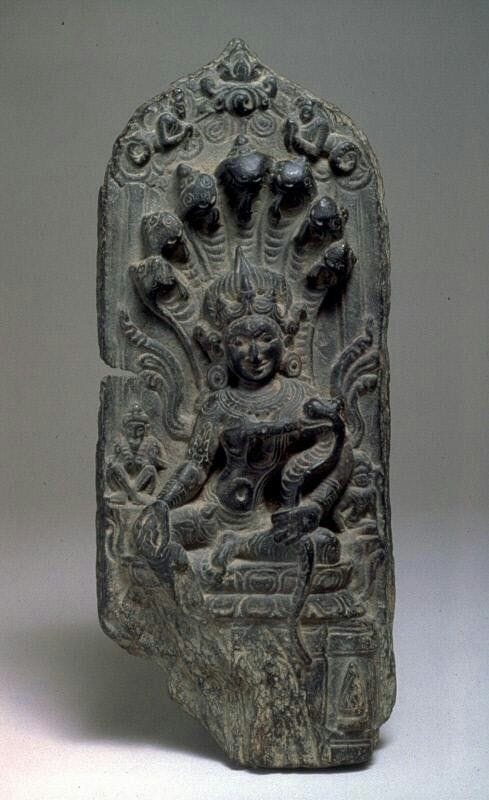
“If you read the old books of natural history, you will find they say that when the mongoose fights the snake and happens to get bitten, he runs off and eats some herb that cures him. That is not true. The victory is only a matter of quickness of eye and quickness of foot, -- snake's blow against mongoose's jump, -- and as no eye can follow the motion of a snake's head when it strikes, that makes things much more wonderful than any magic herb.”
- Rikki Tikki Tavi, Rudyard Kipling

